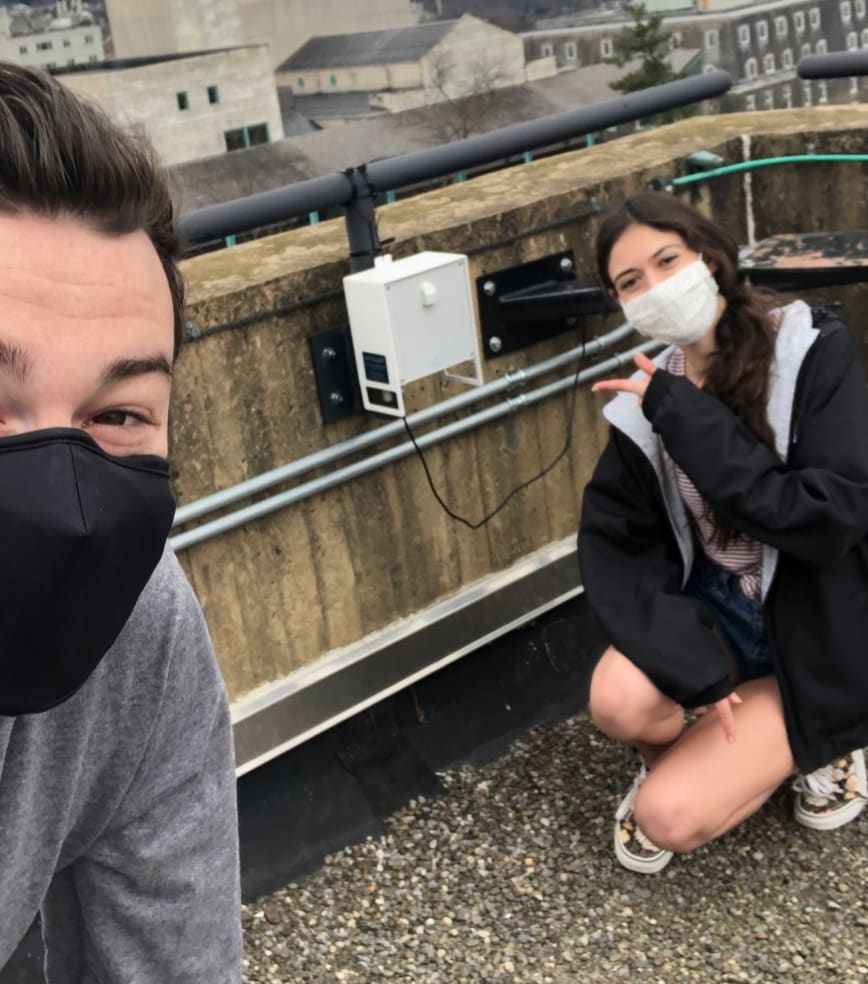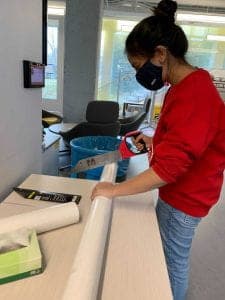This project is now in update mode. Check back regularly to see how things are progressing.
CU Geodata: The World in Our hands
WHO WE ARE
CU GeoData is a student-run project team composed of students passionate about integrating the fields of Earth and atmospheric sciences with engineering. We develop and deploy novel instrumentation to record atmospheric, geologic, and hydrologic variables.
With a strong foundation in Earth and atmospheric sciences, CU GeoData leverages student knowledge of the physical and chemical processes that shape the natural world, to inform our engineering solutions. We apply this interdisciplinary approach to a range of projects.
By integrating earth and atmospheric sciences with engineering, CU GeoData is uniquely positioned to address complex environmental issues that require a deep understanding of the natural systems at play. Through collaborative efforts, the team aims to explore the complex interactions between natural systems and human activities, and to develop innovative solutions to some of the most pressing environmental challenges of our time.
MEET THE FIVE SUB-TEAMS OF GEODATA
1. AIR TEAM
The air team is responsible for tackling atmospheric chemistry and air quality data as well as improving weather balloon payloads and instrumentation. We currently are undertaking two main projects: Finger Lakes forecasting via tethersonde and atmospheric chemistry.

Designing the Tethersonde
The first project involves the use of tethersondes, which are radiosondes attached to balloons that move upward and downward at a fixed location that measure atmospheric upper air data for the Finger Lakes region. All data collection will enhance understanding of surface friction on different atmospheric variables, mainly as a means of improving weather forecasting in the Ithaca area. This will aid in providing reliable and accurate meteorological forecasting for south-central New York. Because the nearest tethersonde is located in Buffalo, soundings taken there would not correctly predict variables in the Ithaca due to topographical differences (e.g., gorges, ridges, creeks, and lakes), so analyzing the local low-level environment will be important to understand the near-Ithaca boundary layer and how this will be proven useful to future weather forecasts. On the left image, Sam Jurado, member of the Air Team, designs the tethersonde.

Atmospheric Chemistry
The later project, atmospheric chemistry, aims to install a network of monitoring stations whose main objective centers on gathering measurements of local pollutants and their precursor quantities (e.g., ozone, nitrous oxides, and particulate matter). These measurements will prompt investigations of possible health risks, topographic features inhibiting pollutant dispersion, and expected meteorological condition-dependent pollutant persistence by combining this data with those from weather stations at the Ithaca Airport and Game Farm Road on Cornell's main campus. The photo shows the deployment of the atmospheric sensor atop Snee Hall on Cornell's campus.
2. ROCK TEAM

The rock team is responsible for measuring and monitoring the quality and stability of soil in our region. Microorganism biodiversity, erosion resistance, agricultural productivity, and conservation of the water table highly depend on soil stability, which is dependent on soil moisture. The rock team will be responsible for constructing three self-sustaining soil moisture instruments adapted from FreeStation and RaspberryPi builds. Members will then profile basic changes of surface soil under a multitude of moisture conditions through x-ray deflection (XRD).
Current Projects
- 1. The CU GeoData Rock Sub-team is focusing on comparing satellite imaging of the Empire State Mine tailings, an underground zinc mine in upstate New York. Each member on the team will be working with different imaging techniques such as Sentinel 2, Landsat 8, and MODIS on Google Earth Engine and WorldView-3, and primarily looking into the levels of zinc around the area. The team will also review tailing samples from the mine and compare to see how variations in zinc affect vegetation and the surrounding environment.
- 2. Silt loam samples (topsoil) varying in organic matter will be collected to determine whether mineral changes are dependent on organo-mineral interactions resulting from soil moisture modifications
- 3. Changes in mineralogy will be done through spectroscopic analysis, such as X-ray fluorescence spectrometry (XRF) or other useful methods.
- On the upper left, rock team member Yasamin Bayley solders the freestation.

2. WATER TEAM
The CU GeoData Water team is a passionate and highly skilled group of professionals dedicated to addressing water-related challenges through the power of geospatial data. With a profound understanding of water science and cutting-edge geospatial technologies, our team brings together expertise in hydrology, sensing, and GIS to deliver innovative solutions for water quality assessment, water resource management, and more. By leveraging advanced geospatial tools and techniques, we aim to empower decision-makers, researchers, and communities in making well-informed choices regarding water management and conservation. Our unwavering commitment to sustainability and excellence places the Water team at the forefront of utilizing geospatial data to promote effective water resource stewardship, ensuring a more resilient future for all.
Current Project
- Harmful Algal Bloom Insight
- The water team collaborates with the data team to develop a model capable of detecting Harmful Algal Blooms before they occur. This semester we are focusing on forming strong parameters for the predictor and continuing our instrumental builds in order to house the data ourselves! The other data we use comes from the Citizen Science Institute and the US Geological Survey, which provides a significant amount of data about Cayuga Lake and surrounding watersheds. This data allows us to train the HAB predictor model to a high accuracy.
- Hydroelectric Demo
- The Water team is actively building a hydroelectric screw turbine demo for visitors and installing a sap-flow sensor to measure how sap-flow changes by time and location.
- Water Cycle Monitoring
- SmartRock sensor - the water team is currently working on our own build of a SmartRock sensor in order to measure various water quality parameters on the lake.
- Micro hydroelectric power system - in order to measure variation in stream velocity in local watersheds, we are building a small turbine system to deploy in a stream at the Cayuga Nature Center.
- Sap flow measuring network - this semester we will deploy a Dynamax sap flow system - in order to gain insight into long-term changes in water uptake in the hydrological cycle.
- Visualizing patterns in cycle. As part of our inner team development the water team has done Geospatial Information System (GIS) workshops in order to teach new members how to use services such as QGIS, ArcGISPro, and Google Earth Engine. This allows members to learn new skills that are relevant to the industry, and also provides visualizations for the team to demonstrate our data.
Past Projects

- Remote Sensing HABs
- Harmful algal blooms remote sensing, which focuses on retrieving satellite data to produce images of present HABs in Cayuga Lake by using software in R (a programming language) called "waterquality". The images will give members information regarding color, size, and extent of the HABs, with the former currently being created along with all other images using Sentinel 2 satellite data.
- Shown on the right are images of Cayuga Lake's harmful algal blooms using different water quality systems.
3. BUSINESS TEAM

The business team is the backbone of CU GeoData — we are responsible for promotional material, budgeting requirements, website management, and supply purchasing. Specifically, the business team is responsible for planning yearly and semester budgets, creating and maintaining sponsorship relations, designing and managing our website with tools like Canva, and working with our Outreach Lead on science communication regarding environmental and project focused blog posts.
4. DATA TEAM
The CU GeoData Data team is dedicated to providing comprehensive support for all data-related projects within CU GeoData. We thrive in an Agile environment, fostering collaboration and delivering impactful, data-driven solutions to the global community. Our team not only facilitates ongoing projects but also takes the initiative to initiate original endeavors aimed at developing innovative data-driven perspectives and promoting the application of Data Science skills.
Current Project
- Waves
- The data team’s primary project is WAVES Reports, a product that incorporates Generative AI to assist the model pre-processing pipeline of ideally any future Data Science projects. Aims to have Wave One and a frontend application go live by the end of the spring '24 academic semester. Besides, the data team is currently facilitating CU GeoData’s ongoing projects, especially on HABs Insights in collaboration with the water team. Project members can take advantage of the existing Machine Learning platforms and resources implemented by the data team.
5. TECH TEAM

Current Project
- Temperature Probe
- This year, the tech subteam will be working on a continuous temperature probe for Cayuga Lake. We plan to build a device that can monitor temperature across different lake strata, and will also include depth, salinity, and pollutant sensors to provide a comprehensive dataset of lake conditions. Once complete, this project will help further GeoData research on HABs (Harmful Algae Blooms) that form in Cayuga Lake and help us to understand the specific conditions in which they form. We will also be able to use the data collected to monitor and understand how lake conditions are affected by the changing local climate.
WE ARE EXTREMELY THANKFUL FOR YOUR SUPPORT AND GENEROSITY TOWARDS OUR MISSION!

$20
Circuit Sensor Purchase
This donation allows us to purchase sensors for general use and the testing of environmental data collection instruments, such as the CU GeoData tethersonde.
$50
Hardware store trip
This donation allows us to buy the necessary hardware for field research, such as dig sites and instrument build equipment. Save us a trip to the hardware store!
$100
Data Stream Maintenance
This donation allows us continue receiving data from our instrumentation. Donations will be used to maintain sensor connectivity for public data access.
$200
Zynect soil moisture sensors
This donation allows us to measure volumetric soil water content, the data for which will be incorporated into the larger CU GeoData sensor network and used by the Emergent Climate Risk Lab for seasonal drought forecasting. The sensor will be named in donor's honor.
$490
2 Essential Well Water Tests
This donation allows us to conduct EPA certified water testing for over 52 analytes, such as heavy metals, fertilizer contamination, and bacteria. This data will be used to monitor water health in vulnerable Tompkins county areas.
$1,100
Air Quality Sensor
This donation allows us to measure temperature, relative humidity, barometric pressure, carbon dioxide concentrations, particulate matter, and volatile organic compounds and will be used to make real-time air quality decisions during summer wildfires and track seasonal vegetation health. The sensor will be named in donor's honor, for which the data is publicly visible on Air Quality Egg Website: https://airqualityegg.com/portal/
$2,500
Basic Weather Station
This donation will allow us to deploy an additional weather station. Each weather station measures temperature, relative humidity, wind speed and relative direction, and precipitation, which is then used to supplement the existing Northeast Weather Association weather station network. Collected data is used for research and New York State integrated pest management. Station will be named in donor's honor, for which the data will be accessible on the NEWA website: https://newa.cornell.edu/


